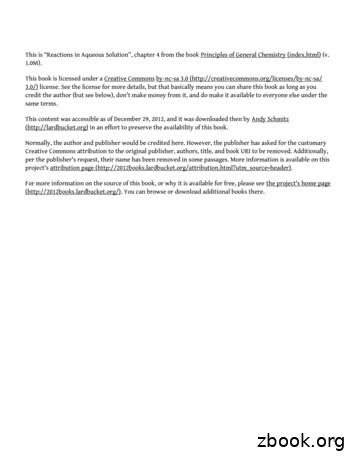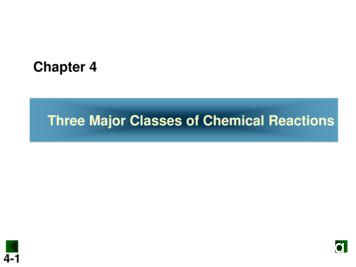Chapter 7 Reactions In Aqueous Solutions - Hsbr1
Chapter 7Reactions in AqueousSolutionsCopyright Cengage Learning. All rights reserved1
Section 7.1Predicting Whether a Reaction Will OccurFour Driving Forces Favor Chemical Change1.2.3.4.Formation of a solidFormation of waterTransfer of electronsFormation of a gasCopyright Cengage Learning. All rights reserved2
Section 7.2Reactions in Which a Solid FormsPrecipitation A reaction in which a solid forms is called aprecipitation reaction. Solid precipitateCopyright Cengage Learning. All rights reserved3
Section 7.2Reactions in Which a Solid FormsWhat Happens When an Ionic Compound Dissolves in Water? The ions separate and move around independently.Strong electrolyte – each unit of the substance thatdissolves in water produces separated ions.Copyright Cengage Learning. All rights reserved4
Section 7.2Reactions in Which a Solid FormsWhat Happens When an Ionic Compound Dissolves in Water? K2CrO4(aq) Ba(NO3)2(aq) ProductsCopyright Cengage Learning. All rights reserved5
Section 7.2Reactions in Which a Solid FormsHow to Decide What Products Form K2CrO4(aq) Ba(NO3)2(aq) ProductsThe mixed solution contains four types of ions: K ,CrO42–, Ba2 , and NO3–.Determine the possible products from the ions in thereactants. The possible ion combinations are:Copyright Cengage Learning. All rights reserved6
Section 7.2Reactions in Which a Solid FormsHow to Decide What Products Form Decide which is most likely to be the yellow solidformed in the reaction.K2CrO4(aq)reactantBa(NO3)2(aq) reactantThe possible combinations are KNO3 and BaCrO4. KNO3white solid BaCrO4yellow solidCopyright Cengage Learning. All rights reserved7
Section 7.2Reactions in Which a Solid FormsUsing Solubility RulesCopyright Cengage Learning. All rights reserved8
Section 7.2Reactions in Which a Solid FormsUsing Solubility Rules Predicting Precipitates Soluble solid Insoluble solid Slightly soluble solidCopyright Cengage Learning. All rights reserved9
Section 7.2Reactions in Which a Solid FormsHow to Predict Precipitates When Solutions of Two IonicCompounds Are Mixed1. Write the reactants as they actually existbefore any reaction occurs. Remember thatwhen a salt dissolves, its ions separate.2. Consider the various solids that could form. Todo this, simply exchange the anions of theadded salts.3. Use the solubility rules (Table 7.1) to decidewhether a solid forms and, if so, to predict theidentity of the solid.Copyright Cengage Learning. All rights reserved10
Section 7.2Reactions in Which a Solid FormsConcept CheckWhich of the following ions form compoundswith Pb2 that are generally soluble in water?a)b)c)d)e)Copyright Cengage Learning. All rights reservedS2–Cl–NO3–SO42–Na 11
Section 7.2Reactions in Which a Solid FormsConcept CheckA sodium phosphate solution reacts with a lead(II)nitrate solution. What precipitate, if any, will form?a)b)c)d)Copyright Cengage Learning. All rights reservedPb3(PO4)2NaNO3Pb(NO3)2No precipitate will form.12
Section 7.2Reactions in Which a Solid FormsConcept CheckConsider a solution with the following ions present:NO3- , Pb2 , K , Ag , Cl- , SO2-4 , PO3-4When all are allowed to react (and there is plentyavailable of each), how many different solids willform? List them.Five different solids will form.PbCl2, PbSO4, Pb3(PO4)2, AgCl, Ag3PO4Copyright Cengage Learning. All rights reserved13
Section 7.3Describing Reactions in Aqueous SolutionsTypes of Equations for Reactions in Aqueous Solutions1. Molecular Equation Shows the complete formulas of allreactants and products. It does not give a very clear picture ofwhat actually occurs in solution.Copyright Cengage Learning. All rights reserved14
Section 7.3Describing Reactions in Aqueous SolutionsTypes of Equations for Reactions in Aqueous Solutions2. Complete Ionic Equation All strong electrolytes are shown as ions. Notice: K and NO3– ions are present in solutionboth before and after the reaction.Copyright Cengage Learning. All rights reserved15
Section 7.3Describing Reactions in Aqueous SolutionsTypes of Equations for Reactions in Aqueous Solutions2. Complete Ionic Equation Spectator ions – ions which do notparticipate directly in a reaction insolution.Copyright Cengage Learning. All rights reserved16
Section 7.3Describing Reactions in Aqueous SolutionsTypes of Equations for Reactions in Aqueous Solutions3. Net Ionic Equation Only those components of the solutionthat undergo a change. Notice: Spectator ions are not shown in the netionic equation.Copyright Cengage Learning. All rights reserved17
Section 7.3Describing Reactions in Aqueous SolutionsConcept CheckWrite the correct molecular equation, complete ionicequation, and net ionic equation for the reaction betweencobalt(II) chloride and sodium hydroxide.Molecular Equation:CoCl2(aq) 2NaOH(aq) Co(OH)2(s) 2NaCl(aq)Complete Ionic Equation:Co2 (aq) 2Cl (aq) 2Na (aq) 2OH (aq) Co(OH)2(s) 2Na (aq) 2Cl (aq)Net Ionic Equation:Co2 (aq) 2OH (aq) Co(OH)2(s)Copyright Cengage Learning. All rights reserved18
Section 7.4Reactions That Form Water: Acids and BasesArrhenius Acids and Bases A strong acid is one in which virtuallyevery molecule dissociates (ionizes) inwater to an H ion and an anion.Copyright Cengage Learning. All rights reserved19
Section 7.4Reactions That Form Water: Acids and BasesStrong Acids Behave as Strong ElectrolytesCopyright Cengage Learning. All rights reserved20
Section 7.4Reactions That Form Water: Acids and BasesArrhenius Acids and Bases A strong base is a metal hydroxide that iscompletely soluble in water, giving separateOH ions and cations. Most common examples: NaOH and KOHCopyright Cengage Learning. All rights reserved21
Section 7.4Reactions That Form Water: Acids and BasesArrhenius Acids and Bases The products of the reaction of a strong acidand a strong base are water and a salt. Net ionic equation Salt Ionic compoundH (aq) OH (aq) H2O(l)Reaction of H and OH is called an acidbase reaction. H acidic ionOH basic ionCopyright Cengage Learning. All rights reserved22
Section 7.4Reactions That Form Water: Acids and BasesSummary of Strong Acids and Strong Bases1. The common strong acids are aqueoussolutions of HCl, HNO3, and H2SO4.2. A strong acid is a substance that completelydissociates (ionizes) in water (into H ionsand anions).3. A strong base is a metal hydroxidecompound that is very soluble in water (anddissociates into OH– ions and cations).Copyright Cengage Learning. All rights reserved23
Section 7.4Reactions That Form Water: Acids and BasesSummary of Strong Acids and Strong Bases4. The net ionic equation for the reaction of astrong acid and a strong base is always thesame: it shows the production of water.5. In the reaction of a strong acid and a strongbase, one product is always water and theother is always an ionic compound called asalt, which remains dissolved in the water.This salt can be obtained as a solid byevaporating the water.Copyright Cengage Learning. All rights reserved24
Section 7.4Reactions That Form Water: Acids and BasesSummary of Strong Acids and Strong Bases6. The reaction of H and OH– is often called anacid-base reaction, where H is the acidic ionand OH– is the basic ion.Copyright Cengage Learning. All rights reserved25
Section 7.4Reactions That Form Water: Acids and BasesConcept CheckThe net ionic equation for the reaction of HNO3 andLiOH isa)b)c)d)H NO3– LiOH H2O LiNO3HNO3 LiOH H2O LiNO3H OH– H2OLi NO3– LiNO3Copyright Cengage Learning. All rights reserved26
Section 7.5Reactions of Metals with Nonmetals (Oxidation–Reduction)Oxidation–Reduction Reaction Reactions between metals and nonmetalsinvolve a transfer of electrons from the metalto the nonmetal.A reaction that involves a transfer of electrons. 2Mg(s) O2(g) 2MgO(s)Copyright Cengage Learning. All rights reserved27
Section 7.5Reactions of Metals with Nonmetals (Oxidation–Reduction)Concept CheckWhich of the following best describes what ishappening in the following representation of anoxidation–reduction reaction:a)b)c)d)Metal Al gains 3 e– and O2 – in Fe2O3 loses these 3e–.Metal Al gains 3 e– and Fe3 in Fe2O3 loses these 3e–.Metal Al loses 3 e– and O2 – in Fe2O3 gains these 3e–.Metal Al loses 3 e– and Fe3 in Fe2O3 gains these 3e–.Copyright Cengage Learning. All rights reserved28
Section 7.5Reactions of Metals with Nonmetals (Oxidation–Reduction)Characteristics of Oxidation–Reduction Reactions1. A metal–nonmetal reaction can always beassumed to be an oxidation–reductionreaction, which involves electron transfer.2. Two nonmetals can also undergo anoxidation–reduction reaction. At this point wecan recognize these cases only by lookingfor O2 as a reactant or product. When twononmetals react, the compound formed isnot ionic.Copyright Cengage Learning. All rights reserved29
Section 7.6Ways to Classify ReactionsDriving Forces for a Reaction Formation of a solidFormation of waterTransfer of electronsFormation of a gasCopyright Cengage Learning. All rights reserved30
Section 7.6Ways to Classify ReactionsPrecipitation Reaction Formation of a solid when two solutionsare mixed. Notice this is also a double–displacement reaction. AB CD AD CBCopyright Cengage Learning. All rights reserved31
Section 7.6Ways to Classify ReactionsAcid–Base Reaction Involves an H ion that ends up in theproduct water. H (aq) OH (aq) H2O(l)HCl(aq) KOH(aq) H2O(l) KCl(aq)Copyright Cengage Learning. All rights reserved32
Section 7.6Ways to Classify ReactionsOxidation–Reduction Reaction Transfer of electrons 2Li(s) F2(g) 2LiF(s)Copyright Cengage Learning. All rights reserved33
Section 7.6Ways to Classify ReactionsFormation of a Gas Oxidation–reduction reactionSingle–replacement reaction A BC B ACCopyright Cengage Learning. All rights reserved34
Section 7.7Other Ways to Classify ReactionsCombustion Reactions Involve oxygen and produce energy (heat) sorapidly that a flame results. CH4(g) 2O2(g) CO2(g) 2H2O(g)Special class of oxidation–reduction reactions.Copyright Cengage Learning. All rights reserved35
Section 7.7Other Ways to Classify ReactionsSynthesis (Combination) Reactions A compound forms from simpler materials. C(s) O2(g) CO2(g)Special class of oxidation–reduction reactions.Copyright Cengage Learning. All rights reserved36
Section 7.7Other Ways to Classify ReactionsDecomposition Reactions Occurs when a compound is broken downinto simpler substances. 2H2O(l) 2H2(g) O2(g)Special class of oxidation–reduction reactions.Copyright Cengage Learning. All rights reserved37
Section 7.7Other Ways to Classify ReactionsSummaryCopyright Cengage Learning. All rights reserved38
Section 7.7Other Ways to Classify ReactionsConcept CheckThe reaction between hydrogen and oxygen to formwater2H2 O2 2H2Ocan be classified as a(n) bustionAll of the aboveCopyright Cengage Learning. All rights reserved39
1. The common strong acids are aqueous solutions of HCl, HNO3, and H2SO4. 2. A strong acid is a substance that completely dissociates (ionizes) in water (into H ions and anions). 3. A strong base is a metal hydroxide compound that is very soluble in water (and dissociates into OH- ions and cations). Summary of Strong Acids and Strong Bases
Chapter 4 Reactions in Aqueous Solution 4.1 Aqueous Solutions 405. Figure 4.2 The Structure of Liquid Water Two views of a water molecule are shown: (a) a ball-and-stick structure and (b) a space-filling model. . Chapter 4 Reactions in Aqueous Solution 4.1 Aqueous Solutions 408. An. elect
Chemistry 11 Solutions 978‐0‐07‐105107‐1 Chapter 9 Reactions in Aqueous Solutions MHR 1 Chapter 9 Reactions in Aqueous Solutions . Section 9.1 Net Ionic Equations and Qualitative Analysis . an aqueous solution of sodium sulfide is mixed with an aqueous solution of iron(II) sulfate. Write the net ionic equation.
Dr. Mattson, General Chemistry, Chm 203, Chapter 4 Reactions in Aqueous Solution 1 Guide to Chapter 4. Reactions in Aqueous Solutions We will spend three lecture days on this chapter and one review day. In this chapter we will learn to predict several fundamental chemical reactions. This chapter is so important that Exam 3 will cover only this .
Part One: Heir of Ash Chapter 1 Chapter 2 Chapter 3 Chapter 4 Chapter 5 Chapter 6 Chapter 7 Chapter 8 Chapter 9 Chapter 10 Chapter 11 Chapter 12 Chapter 13 Chapter 14 Chapter 15 Chapter 16 Chapter 17 Chapter 18 Chapter 19 Chapter 20 Chapter 21 Chapter 22 Chapter 23 Chapter 24 Chapter 25 Chapter 26 Chapter 27 Chapter 28 Chapter 29 Chapter 30 .
3 in the limestone: Aqueous solutions cenotes in Yucatan - Mexico CaCO 3(s) H 2O(l) CO 2 (aq) Ca(HCO 3) 2 (aq) A solution in which water is the dissolving medium is called an aqueous solution 116 CHAPTER 4 Reactions in Aqueous Solution 4.1 GENERAL PROPERTIES OF AQUEOUS SOLUTIONS A solution is a homogeneous mixture of two or more .
Aqueous Reactions & Sol’n Stoichiometry Chapter 5. Properties of Aqueous . An aqueous solution of sodium carbonate is mixed with an aqueous solution of calcium chloride. A white precipitate immediately forms. Write a net i
Most of these reactions can be classified into one of three main types of chemical reactions: precipitation reactions, acid-base neutralization reactions, and oxidation-reduction (also called “redox”) reactions. Aqueous Solutions(aq) Many reactions occur in an aqueous environment (i.e.,
The Major Classes of Chemical Reactions. 4.6 Elements in Redox Reactions 4.1 The Role of Water as a Solvent 4.2 Writing Equations for Aqueous Ionic Reactions 4.3 Precipitation Reactions 4.4 Acid -Base Reactions. 4.5 Oxidation -Reduction (Redox) Reactions 4.7























